Article 363
- Article 363 bars the interference of the court in the disputes arising out of any treaties or agreements which was entered into or executed before the commencement of our Constitution by any Ruler of an Indian State and to which the Government was a party.
- The two agreements of 1892 and 1924 executed between the Governments of Madras and Mysore on the apportionment of water to Tamil Nadu.
- Karnataka had argued that according to Article 363, the judiciary has no power to intervene in these agreements as they were signed before the commencement of the constitution.
- Supreme Court rejected the argument of the state as the agreements were not political arrangements but based on public interest.
Article 262
- The article 262 of the constitution is an enabling clause that paves the way for Parliament in adjudication of disputes relating to waters of Inter- State Rivers or river valleys.
- Article 262 states that ’Parliament may by law provide for the adjudication of any dispute or complaint with respect to the use, distribution or control of the waters of, or in, any inter-state river or river valley.’
- In exercise of the power conferred by article 262 of the Constitution, Parliament has enacted the Inter-State Water Disputes Act, 1956.
- Interstate water disputes Act provide for establishment of separate Tribunal for each Inter State River Water Dispute.
- Under the provision of the 1956 Act, a request to the Central Government has to be made by a State Government, not by a citizen.
- Article 262 enables the Parliament to oust and exclude the jurisdiction of all courts, including the Supreme Court.
- Article 131 is about Centre-State or inter-State disputes in general, whereas Article 262 is specifically about inter-State river water disputes.
- The interstate river water dispute doesn’t come under the Supreme Court’s Original Jurisdiction.
- So, in this case, the final order of the tribunal was contested under the Special Leave Petition (Article 136) provision.
Chandrayan 2 Mission
- ISRO planning to launch Chandrayaan-2 mission around April, 2018.
- It is the first time India attempts to land a rover on the moon’s South Pole.
- Only USA Russia and China were able to soft land successfully on the lunar surface and these landings were near the lunar equator.
- The components of the mission are – Orbiter, Lander and Rover.
- The purpose of the mission is to collect data on the lunar topography, mineralogy, elemental abundance, lunar exposure and signatures of water-ice.
- India's Chandrayaan-1 mission was its first mission to moon where India was the captain and carrying the payloads built in UK, USA, Bulgaria Germany and Sweden.
- The mission comprised an orbiter and an impactor launched by ISRO’s workhorse PSLV.
- Chandrayaan-1’s greatest discovery was the widespread presence of water molecules in the lunar soil.
Raman Effect
- Raman Effect deals with the change in the wavelength of light that occurs when a light beam is deflected by molecules.
- The method can provide key information easily and quickly by characterizing the chemical composition and structure of a sample.
- Raman Effect has a wide range of application in fields such as geology, material science, forensic science, nuclear science and pharmacology.
- The effect is named after the Indian Physicist Sir C.V.Raman who observed the same.
- He was awarded Nobel Prize in Physics in 1930.
- To mark the discovery of Raman Effect, February 28 is celebrated as the National Science Day in the country.
Invisible oil spill
- The collision in the East China Sea that sank an Iranian tanker gave rise to an odd environmental disaster.
- It is the largest oil spill in the decades yet hasn’t attracted the global attention as it happened in a remote location in the high sea and also due to the type of petroleum spilt – condensate.

- Condensate is a toxic, liquid byproduct of natural gas production and does not clump into black globules that can be easily spotted.
- Absorbed into the water, it will remain toxic for a time; its exposure is extremely unhealthy to humans and potentially fatal.
- The East China Sea area produced five million tons of seafood of up to four dozen species for China including crab, squid, yellow croaker, mackerel and hair tail.
- The only real solution is to let it evaporate or dissolve.
- The condensate may find its way in to the rich Japanese Fisheries source.
Green Good Deeds Campaign
- The campaign is launched by the Union Ministry of Environment, Forest and climate change.
- Its aim is to sensitize the people and students, in particular, about climate change and global warming.
- The Union minster for Environment and forest emphasized the crucial role of ‘Green Sainiks’ in the Green Good Deeds Campaign.
- The plan is to broad-base it with the involvement of teachers, students and other voluntary organizations
Source: PIB, The Hindu, Business Standard